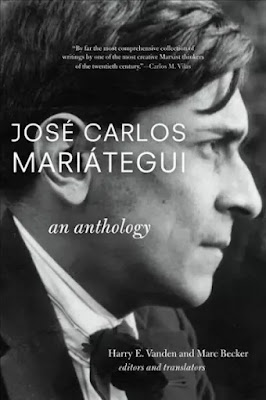“An Anthology of the
Writings of Jose Carlos Mariategui,” forward and translation by Harry Vanden
and Marc Becker, 2011
Some non-fiction books are read to absorb facts. Some books are read to bolster a polemic or
to refine theory. Some books are read
for affirmation. Some for background.
Some even for enjoyment. This book is one of those you read that stimulates thinking. Unless, of course, you are a Peruvian, in
which case it might help on all of these points.
This anthology is a compendium of 3 fragmentary books and
many newspaper articles from the Peruvian Marxist JC Mariategui, from
1924-1930. Mariategui was instrumental
in the founding of the Peruvian workers movement and in a real, concrete and
creative analysis of Peruvian society.
Mariategui in essence uses the Marxist ‘method’ to come to socialist
conclusions about his country, Latin America
and world politics.
One of Mariategui’s great theoretical contributions is the
incorporation of the ‘indigenistas’ – indigenous people – into the socialist
project. Peru Cuzco
His second great contribution was to point out that Inca
society incorporated many aspects of primitive communism that still existed
within the indigenista communities, and that this provided a road for a modern
communist movement to appeal to the Peruvian peasantry on the land
question. His solution to the poverty
and oppression of the native people and the Peruvian land problem was not
social work. It was the destruction of
the feudal land-tenure system which existed in the highlands and the virtual
slavery of the large capitalist farms on the coast dedicated to cotton and
sugar, and their return to collective ‘Inca’ ownership. Small individually-owned plots, according to Mariategui, are not viable - and this has been proved given the experience of the counter-revolution in Russia on agriculture (see review of "The Race for What's Left," below). One example of the "Inca" collective work is the irrigation
projects administered by the peasant communities themselves. (also similar to local
collective Indian water management as mentioned by Vandana Shiva, reviewed
below.) He evaluated the Peruvian capitalist class and saw they could not even
complete a bourgeois revolution in land rights, but in fact ceded power to the
feudal power of ‘Gamonalismo’ – large landowners who also controlled the local
state apparatuses. He makes equations
between the actions of the Soviets regarding the Russian peasant collective ‘mir’
and the Inca equivalent, the ‘ayllu.’
His third contribution was to itemize the semi-colonial/imperial
character of the Peruvian economy, in which cotton, sugar, oil and copper were privately
owned, and pulled out of the country by firms from the United
State s and England ,
the profits exported, and very little left for Peru U.S. London
On questions of organization, he rejected premature attempts
to form a ‘party’ not rooted in the masses, and advocated that all ‘classist’
labor groups be incorporated into one organization - one front. His style was generally one of polemics
against ideas, not people. He opposed
the ostensibly ‘progressive’ but actually bourgeois-nationalist APRA. In 1928, he was finally part of a group
organizing a Marxist and ‘vanguard’ Leninist ‘Socialist Party.’ However, democratic-centralism was not
mentioned related to this group.
Mariategui’s education was wide-ranging, and in these
selections he writes about psychology (Freud), literature (Gorky Peru ,
and elsewhere in Latin America . He describes their attitude as one of looking
down on the former black slaves, the indigenistas and any other non-white nationalities
like the Chinese, and hence they are more likely to sympathize with the
imperialists on even this cultural level.
He opposes Pan-Americanism as a ‘cloak that hides U.S. Mexico and Nicaragua , and also the U.S. military interventions in Haiti , Nicaragua
& Panama
One section is a refutation of a ‘spiritual socialist’
attack on Marxism by Henri de Man, a Belgian, called ‘In Defense of
Marxism.” His comment on de Man’s
approach denounced ‘drug-like Oriental occultism and Asian metaphysics.” However, Mariategui was also influenced by
Catholicism, and incorporated the need for ‘myth’ and ‘belief’ into his
struggle for socialism, somewhat similar to the role it plays for Zizek. (see several
Zizek books, reviewed below.) Mariategui
was a Leninist in the sense that he believed the working class could not
passively wait for capitalism to collapse, but that it had to rise to the
historical occasion. But he adds that in
essence, the voluntarism of a revolutionary is driven not just by logic or
reason, but by an over-arching myth that can also transform a proletariat. The anthology links his influence to the
development of Latin American “liberation theology’ by Gustavo Gutierrez.
Mariategui’s method is to look at the actual conditions of Peru
And I bought it at May Day Books! xxxxx
Red Frog / September 16, 2012



No comments:
Post a Comment